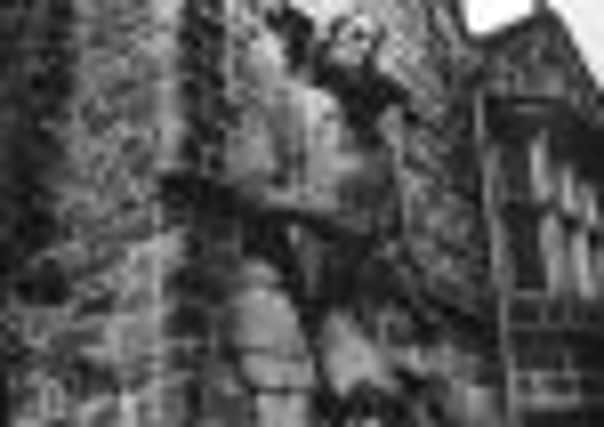Judge hands down harsh sentences


Somehow I don’t think William Glossop is ever going to get the Freedom of Bradford. Here’s what he thinks about the city: “There is scarcely a more desolate experience than a walk from the thriving National Media Museum, past the abandoned Odeon, up Tetley Street with split open warehouses and truncated chimneys to City Road where, going west, you pass semi-derelict mills...”
Glossop is writing in his new and long-awaited Heritage Shell Guide to West Yorkshire, a city-by-city, town-by-town, village-by-village portrait of the county. Most of the book is positive, and Glossop enthuses about Bradford’s surviving Victorian architecture. But his overall vision of the city is not the stuff of tourist brochures.
Advertisement
Hide AdAdvertisement
Hide AdMuch of it is down at heel, he says. “Bradford had tried for success by demolishing half of the glorious Victorian buildings in its centre but still cannot make a go of modern commerce. It has now demolished half the town centre for the second time since the Second World War and cannot afford to rebuild.”
Though “the parts of the city where the politicians and developers have not played God remain of great interest”, he reckons “there appears to be a strong irrational element in Bradford’s planning mind.” And the Industrial Museum is “a wasted opportunity which might have shown the history and glory of the Bradford worsted trade to a new generation; it should be in a museum for unimaginative museums”.
The book has been a long time coming. It was originally commissioned in 1974 as a Shell Guide, one of the long-running series sponsored by the oil company to celebrate Britain and promote motoring holidays. Glossop, a writer and lawyer then based in the Sheffield area, was invited to compile it, but it was unfinished when the series was wound up a few years later.
There the story might have ended, but an article in this magazine five years ago alerted the Bishop of Wakefield, the Rt Rev Stephen Platten (a self-confessed “Shell Guide freak”), to a similar guide to North Yorkshire which had just been published many years after its commission. A trail of enquiries led him to William Glossop, and the Heritage Shell Guide Trust was formed to get the West Yorkshire guide published and to commission more.
Advertisement
Hide AdAdvertisement
Hide AdThough now working in London as an immigration judge and living in Somerset, Glossop has revisited both the area and his old manuscript, to reflect the huge post-industrial changes of the past 30 years.
“The smell and grittiness of West Yorkshire has subsided,” he writes. “Thirty years ago there remained many collieries with associated spoil heaps... That has all gone now.” At Caphouse Colliery, now the National Coal Mining Museum, “the sound of miners singing in the white tiled baths brings the place alive, but it is a tape”.
Some of the places due to feature in the Seventies Shell Guide were photographed at the time by Peter Burton from Brompton-by-Sawdon, near Scarborough. He worked on many of the guides and wrote the 2006 North Yorkshire one.
Following the Shell tradition, these original pictures were in black-and-white, and because, as Glossop says, “they cannot be bettered”, some are included in the new book, along with more recent ones, notably by Scarborough-born Harland Walshaw, who has a long working partnership with Burton. There’s a handful of colour pictures, but most – around 200 – are still black-and-white. They may look novel to modern eyes accustomed to colour, but many wonderfully capture the sturdy, rugged texture of the county’s landscape and architecture.
Advertisement
Hide AdAdvertisement
Hide AdSo does William Glossop’s prose. As a judge, he doesn’t shrink from giving his verdict on the places he describes, and is opinionated and outspoken. The megalithic block of flats that towers over Pontefract is “a lunatic imposition on this Georgian town”. Leeds City Museum is “a starkly repellent building”. At Harewood House, Epstein’s startlingly big sculpture of Adam in the entrance hall, is “out of scale... Is it a bad joke?”
He seems happiest analysing architecture (he can out-Pevsner Pevsner with his technical terms), but can also summon a vivid “sense of place” in his gazetteer entries, which include mosques as well as mills and museums.
Here he is, evocatively listing favourite impressions: “Jacobean Scout Hall near Halifax, its windows unglazed for decades and surrounded by long grass, looks down over unspoiled Shibden Dale... Haworth Parsonage in the grip of snow, icicles clinging to gutters, the silent wooded churchyard listening to stories from the past... one’s first sight of Halifax by night with car headlamps seeming to ride through the sky.”
Buckstones Edge has “gigantic waves of moorland, its rough grass bent east by the ever blowing wind”. Hebden Bridge has “the quality of an alpine retreat”. And Haworth is “reminiscent of a Cornish or Yorkshire fishing village – you look down onto higgledy-piggledy roof tops of houses below”. Though “over the last 20 years there has been a degree of development which is not sustainable and threatens to ruin the village character”.
Advertisement
Hide AdAdvertisement
Hide AdThe guide, a paperback, includes interesting walking, cycling and motoring tours of major towns and cities, together with plans. Occasionally, however, it has less to say about interesting places than you might expect. “The Gothic cemetery at Undercliffe displaying the symbolic hopes and fears of the Victorian settlers to this town, both mill owners and mill workers” doesn’t do justice to Bradford’s astonishing hilltop necropolis.
Small reservations aside, though it adds up to a real browser’s book. “I wonder what he makes of Keighley,” you might find yourself thinking. I certainly found myself wondering why I’ve never been to Adel’s “jewel of a church”. Glossop will be welcome there. But best steer clear of Bradford.
Heritage Shell Guide: West Yorkshire by William Glossop. Canterbury Press (£20).